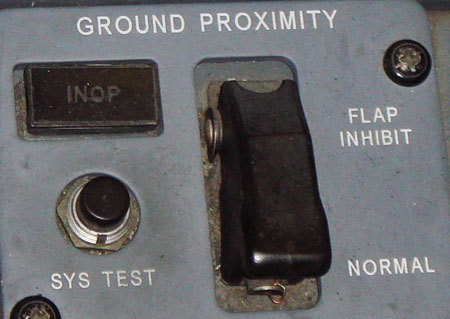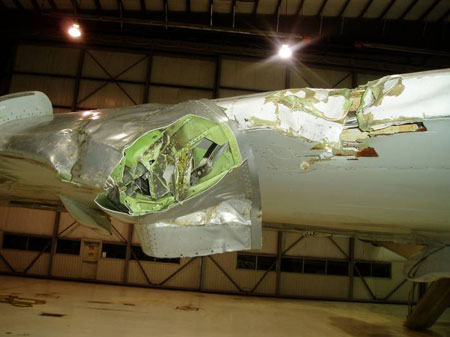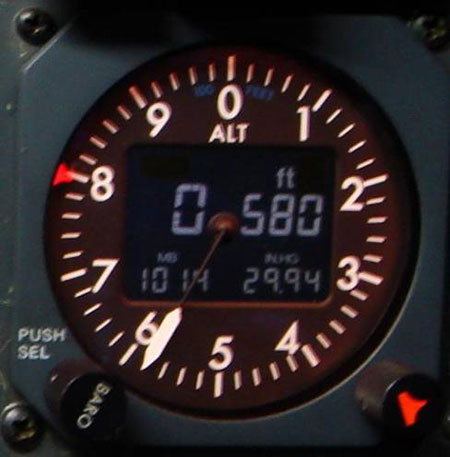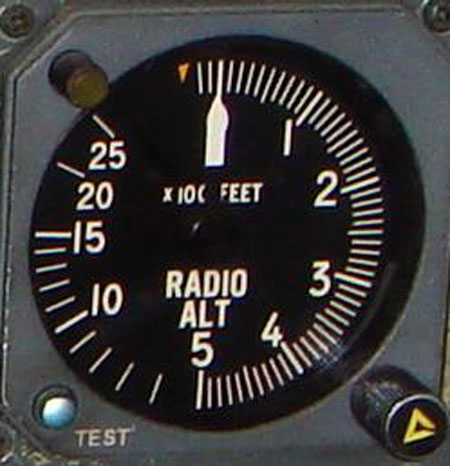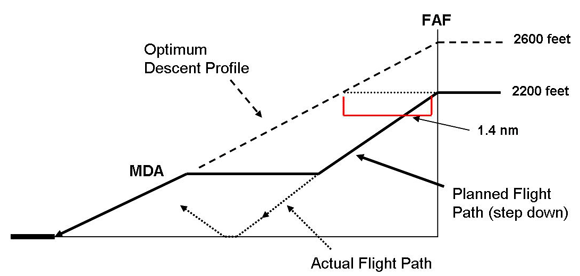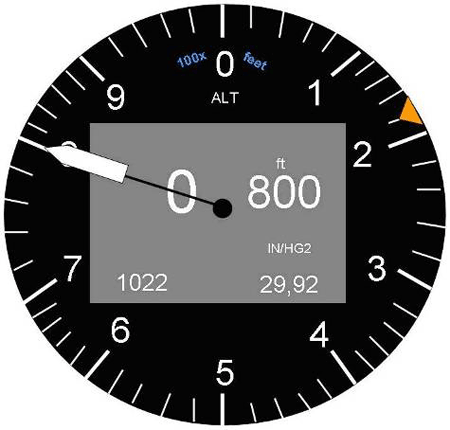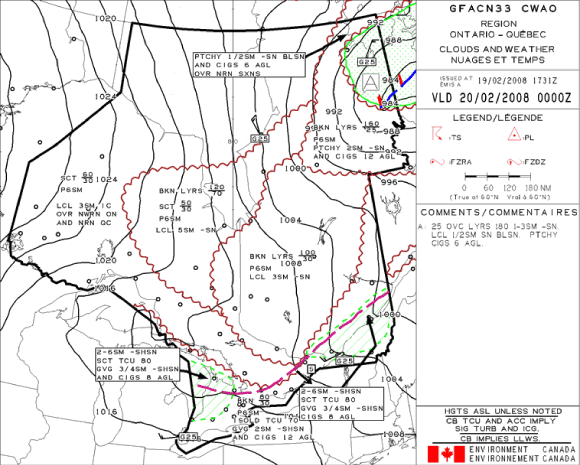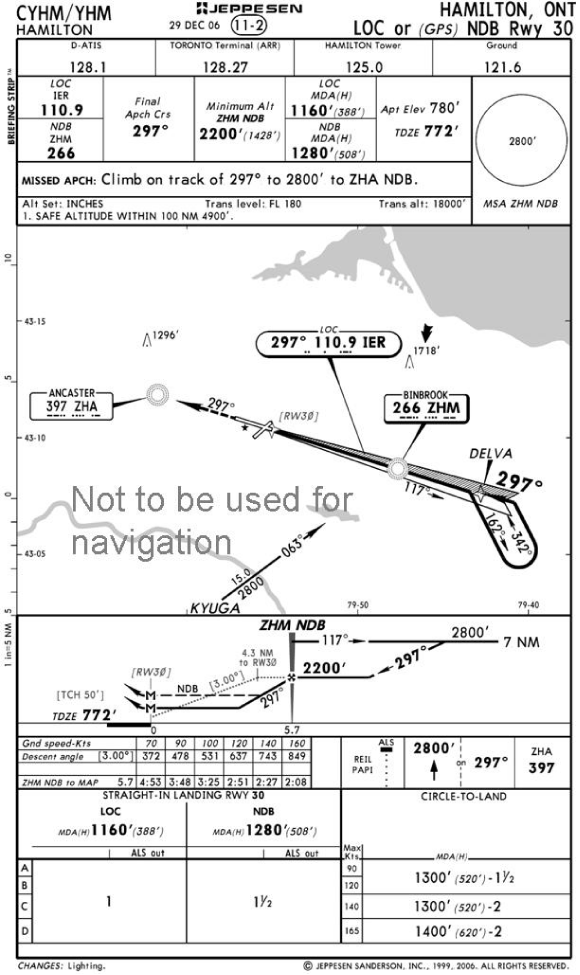Collision with Trees on Approach
Cargojet Airways Limited
Boeing 727-260 C-GUJC
Hamilton, Ontario
The Transportation Safety Board of Canada (TSB) investigated this occurrence for the purpose of advancing transportation safety. It is not the function of the Board to assign fault or determine civil or criminal liability. This report is not created for use in the context of legal, disciplinary or other proceedings. See Ownership and use of content. Masculine pronouns and position titles may be used to signify all genders to comply with the Canadian Transportation Accident Investigation and Safety Board Act (S.C. 1989, c. 3).
Summary
The Boeing 727-260 (registration C-GUJC, serial number 21979) operating as Cargojet Airways Limited flight CJT575 was on a night instrument flight rules cargo flight from Montréal International (Mirabel) Airport, Quebec, to Hamilton, Ontario, with three crew members on board. A non-precision approach to Runway 30 was flown in night instrument meteorological conditions. The aircraft struck trees 2.7 nautical miles from the threshold of the runway while conducting a go-around. A second approach was performed successfully to the same runway and the aircraft landed at 2337 Eastern Standard Time. A post-flight inspection of the aircraft found substantial damage to the right wing, the right landing gear door, and anti-skid electrical harness. There were no injuries.
Factual information
History of the Flight
The crew reported for duty at Montréal International (Mirabel) Airport, Quebec (CYMX), at 2030Footnote 1 for a scheduled flight to Hamilton, Ontario (CYHM), Winnipeg, Manitoba (CYWG), and Vancouver, British Columbia (CYVR).
The captain occupied the right seat and was the pilot not flying (PNF), while the first officer occupied the left seat as the pilot flying (PF). The second officer occupied the centre position between the two pilots.
The weather at CYHM was reported to be visual meteorological conditions (VMC) with a forecast possibility of reduced visibility in snow just before the planned arrival time of 2330 (see Appendix A — Hamilton Weather).
The aircraft was de-iced prior to departure and took off at 2227. Shortly after departure, the radio altimeter began to fluctuate. The crew pulled the circuit breaker to deactivate the radio altimeter and the INOPFootnote 2 light illuminated on the ground proximity warning system (GPWS) control panel. This aircraft was fitted with only one radio altimeter providing radio altitude signals to the two display indicators in the cockpit. Thus, both indicators were now inactive.
The en route portion of the flight to CYHM was uneventful. The approach preparation and briefing were completed prior to descent. The automated terminal information system (ATIS) information Echo at 2200 was reporting the weather at CYHM as VMC, with visibility 10 miles Footnote 3 in light snow showers. The crew anticipated, briefed, and later received a clearance to conduct a localizer (LOC) approach to Runway 30 (see Appendix B — Jeppesen Approach Chart (Hamilton)). It was expected that the runway would be in sight when established on final approach, prior to the final approach fix (FAF).
At 2301, the descent was initiated from FL 320.Footnote 4 Seven minutes later, ATIS information Foxtrot was issued, indicating a visibility of six miles in light snow showers.
At 2315, the CYHM airport controller observed that the visibility was reduced to approximately one mile in snow showers and advised the Toronto area control centre (ACC). This information was relayed by the Toronto ACC controller to another aircraft on approach into CYHM on the same frequency as, but not directly to, the occurrence flight.
At 2320, the occurrence aircraft was established on final to Runway 30 and was transferred to the CYHM tower controller. The crew was then advised that the visibility at the airport was approximately one mile in snow showers.
At 2323:04, the aircraft passed the Binbrook FAF at the published altitude of 2200 feet above sea level (asl). The FAF is located 5.7 nautical miles (nm) from the threshold of Runway 30, which has a touchdown zone elevation of 772 feet asl. The aircraft was cleared to land and tower passed the current winds, which were 250° Magnetic at 14 knots. The descent to the minimum descent altitude (MDA) was commenced with an initial rate of descent of 1300 feet per minute. The descent rate was later adjusted to an average of 1000 feet per minute until 800 feet asl.
At 2324:06, the aircraft passed the published MDA of 1160 feet asl, with a descent rate approximating 1000 feet per minute. There was no indication in the flight data recorder (FDR) that the crew initiated a level-off.
At 2324:21, the enhanced ground proximity warning system (EGPWS) generated a "Too Low Terrain" aural caution alert on the flight deck with the aircraft descending through approximately 865 feet asl, with a rate of descent of slightly more than 1000 feet per minute. The crew initiated a level-off at approximately 800 feet asl using the autopilot vertical speed wheel.
At 2324:27, the EGPWS "Pull up" aural warning alert occurred with an almost simultaneous pronounced nose-up (aft) control column movement to 80 per cent of travel and go-around thrust application as indicated on the FDR. This manoeuvre resulted in a 1.57g pullout, during which the aircraft reached a minimum altitude of 759 feet asl.
At 2324:29, the aircraft struck some trees while at an altitude of approximately 768 feet asl, with a speed of 156 knots, thrust of 2.2 EPR,Footnote 5 right roll of 9°, and an aircraft pitch of 13.5° nose-up. The height of the trees is approximately 75 feet above ground level (agl) and they were located approximately 2.7 nm from the runway threshold in line with the final approach course. The Hamilton airport controller was advised that a missed approach was being performed and the aircraft was transferred back to Toronto ACC. The crew members then advised Toronto ACC of their intention to perform a second approach to Runway 30 into CYHM.
It is unclear whether the crew members were aware that they had struck trees. The handling characteristics of the aircraft were regarded as normal. There were, however, a few abnormal indications in the cockpit concerning the leading edge flaps when they were in the retracted position. In addition, the right-hand landing gear door and antiskid also displayed faults.
At 2329, the fuel on board was approaching the minimum diversion fuel, and the crew requested the latest weather information for CYHM. When contacted, Toronto ACC passed the 2300 METAR,Footnote 6 which indicated a visibility of six miles. Thinking that the weather had improved from the one mile reported by the CYHM tower, the crew decided to return to CYHM via another LOC Runway 30 approach. The aircraft landed with less than the minimum diversion fuel of 7700 pounds as required by the company Flight Operations Manual (FOM).
At 2333, the aircraft was approximately eight miles on final and the crew switched frequency to the CYHM tower. At this time, the crew was advised that the visibility was two to three miles in snow showers, thus slightly above the reported visibility during the first approach.
The crew did not brief the second approach and the altimeter bugs were likely not reset for the second LOC Runway 30 approach. The FDR information indicates that the aircraft descended 100 feet below the MDA on the second approach before returning to and levelling off at the MDA. From this point, the crew carried out a successful landing.
Crew Information
The crew was certified and qualified for the flight in accordance with existing regulations. The captain, an instructor on the Boeing 727, had accumulated over 41 000 hours' total flying time including approximately 7500 hours on type (Boeing 727).
The first officer was recently hired by the company and had completed his line check as captain on the previous flight, thus was flying from the left seat. He had accumulated 7500 hours' total time, of which 4084 were on type, 54 hours as captain in training, 2390 hours as first officer, and 1640 hours as second officer.
The second officer was also new to the company and had completed his line training and type check on 16 October 2007. He had accumulated 3750 hours' total time, of which approximately 700 hours were on multi-engine aircraft and 260 hours were as second officer on type.
Aircraft Information
A review of the aircraft documentation determined that the aircraft was certified, equipped, and maintained in accordance with existing regulations and approved procedures. Records indicated that there were no outstanding defects for the flight.
Company Information
Cargojet Airways Limited (Cargojet) holds a valid operations certificate issued under subpart 705 of the Canadian Aviation Regulations (CARs).
The company has an altitude awareness policy detailed in the FOM. This policy serves as a guide to prevent misinterpretations of indicated altitude while emphasizing the need for the PF to communicate his intentions to the PNF when changing altitude.
The altimeter setting policy is found in the company standard operating procedures (SOPs). The procedure specifies the standard calls required when the pressure setting is changed, when leaving or approaching an air traffic control (ATC)-cleared altitude, and in the event of a difference in altitude indication. The policy also states the requirement to follow the published altitudes found on the approach charts. This is accomplished using a "set and cross check" procedure, which consists of stating and setting the barometric pressure on the altimeter and crosschecking the altitude readouts on the other pilot's altimeter to ensure that both altimeters indicate the same value.
The SOP requires an approach briefing, which reviews, among other things, the altitudes during the descent and approach. During an approach briefing, the MDA is mentioned and the minimum altitude reference bug on both the PF's and PNF's pressure altimeters are normally set to this value. The PF transfers responsibility for control of the aircraft to the PNF for the approach briefing. The second officer's role involves monitoring the approach. While a detailed procedure for the setting of these bugs is not typically found in SOPs, the common practice is to set the bugs to the corrected MDA during the approach briefing. In some cases, they may already have been set during the approach preparation, and the position of the bugs is verified and called out by both pilots when it is briefed. The investigation could not determine exactly how the altimeter bugs were set.
Enhanced Ground Proximity Warning System (EGPWS)
The aircraft was equipped with a Honeywell Mark VII EGPWS (965-1076-020-213-213). The EGPWS control panel is labelled "Ground Proximity" and the inoperative indication is labelled "INOP" (see Photo 1). There were no indications to the crew that an EGPWS was installed.
The non-volatile memory contained some configuration information, a flight history log, an alerts and warnings log, and a fault history log. The investigation determined that one EGPWS runway field clearance floor (RFCF) – "Too Low Terrain" – caution alert, and one EGPWS Terrain Look Ahead Alerting (TLAA) - "Pull Up" – warning alert occurred on the event flight.
According to the EGPWS Pilot Guide, the recommended response to a caution alert is to stop any descent and climb as necessary to stop the alert, while, for a warning alert, the power is set to maximum-rated thrust, the autopilot is disengaged, and the pitch is aggressively increased towards stick shaker.
In addition to the basic modes found in the GPWS, the EGPWS contains enhanced functions that provide further alerts to the crew using an internal database and a global positioning system (GPS). The enhanced functions of the EGPWS continue to provide alerts even if the radio altimeter fails.
Company Training
The company provided training on the use of the GPWS during ground school and in simulator training as per existing regulation. The SOP does not provide EGPWS caution alert guidance. However, it provides a Pull up/Terrain Avoidance procedure to use when a "Pull Up" warning is generated or when other situations result in unacceptable flight towards terrain. The procedure requires the PF to "disconnect the autopilot; aggressively apply maximum thrust; and roll wings level and rotate to an initial pitch of 20 degrees." Instead of this procedure, the crew carried out the less aggressive go-around procedure with a lower initial target pitch of approximately 10 degrees.
Pulling of the radio altimeter circuit breaker after the take-off from CYMX led to a loss of the basic modes of the EGPWS. It also caused the illumination of the INOP light on the ground proximity control panel in front of the pilots, leading the flight crew to believe that the GPWS was inoperative.
The crew was not aware of the EGPWS modes and warnings available, nor were they familiar with the differences between the conventional GPWS and the newer EGPWS. The terrain avoidance warning is identical for the GPWS and for the EGPWS. No training for the EGPWS was provided, nor is it required by existing regulation because GPWS training is provided.
Aircraft Damage
The aircraft was substantially damaged following the impact with the trees (see Photo 2). Several light scratches were found on the underside of the aircraft, running from forward of the wing root to the tailskid. Most of the damage was concentrated on the right side of the aircraft, with substantial damage to the right leading edge flaps and slats. There was no evidence of damage to the wing's front spar. The right main gear door was damaged and the right anti-skid wiring harness was severed from the brake assembly.
Pressure Altimeter
The pressure altimeter installed on this aircraft has two controls (see Photo 3). The left baro set knob is used to set the barometric pressure in millibars or inches of mercury. The right altitude index set knob is used to set the orange altitude bug or cursor on the outer scale of the indicator (in Photo 3 at 800 feet). It is used to set critical target altitudes such as the MDA.
The white altitude pointer indicates altitude in hundreds of feet, subdivided into 20-foot increments, and each rotation of the pointer equals 1000 feet. The position of this white pointer in relation to the orange altimeter bug is used to determine that the aircraft is approaching a critical altitude such as the MDA. Use of this type of altitude bug, however, requires altitude awareness on the part of the crew, especially for target altitudes above 1000 feet asl.
The SOPs require a callout 100 feet above the MDA during non-precision approaches and another callout at MDA. It could not be determined if this was done during the first approach because the cockpit voice recorder (CVR) had been overwritten.
Pressure altimeters are calibrated to indicate true altitude under ISAFootnote 7 conditions. Any deviation from ISA will result in an erroneous reading on the altimeter. In a case when the temperature is lower than the ISA, the true altitude will be lower than the altitude value indicated by the altimeter. Therefore, temperature corrections are required to be added to the published altitudes on instrument approach charts when the temperature is below 0°C. On the occurrence flight, the published MDA of 1160 feet asl was corrected to 1180 feet asl. The actual temperature correction was 38 feetFootnote 8 and should have been rounded to 40 feet, resulting in a temperature corrected MDA of 1200 feet.
The post-flight investigation revealed that both altimeters were functioning normally and were verified to be within the required parameters. FDR data confirmed that the aircraft was being flown at the altitudes assigned by air traffic services. However, the altimeter bug on the right altimeter (PNF) was found to be set at 800 feet asl, instead of the temperature corrected MDA of 1180 feet asl. The altimeter bug on the left altimeter (PF) was found to be set at the zero position. It was reset to this position by the PF as part of the post-flight routine.
The aircraft instrumentation was observed and photographed in night conditions to evaluate the readability of the pressure altimeter and radio altimeter displays. It was determined that a level of readability of the altitude readings and the altimeter bugs equivalent to those found in daylight conditions was provided using normal background and internal instrument lighting.
Radio Altimeter
The radio altimeter (see Photo 4) displays the altitude of the aircraft above the ground. The white altitude pointer moves within a range of 0 feet to 2500 feet above the ground. The scale expands for indications below 500 feet above the ground to offer more precise readings and to increase low-altitude awareness.
The right-altitude index set knob is used to set the orange altitude bug or cursor on the outer scale of the indicator. It is usually used to set critical altitudes such as decision height (DH).
Flight Recorders
The aircraft was equipped with a tape-based Sunstrand FDR (980-4100-GQUS). The recorder contained approximately 25 hours of data with 11 parameters. The aircraft was also equipped with a Fairchild CVR (93-A100-80). The recording time of this type of unit is 30 minutes; therefore, the conversations prior to and during the tree strike event were overwritten by the conversations during the second approach. The issue of loss of information caused by the 30-minute recorders has been raised on several occasions by the TSB.Footnote 9 The ground staff deactivated the CVR after realising that the extent of the damage to the aircraft constituted a reportable event.
Meteorological Information
The weather observation services for CYHM are contracted out by NAV CANADA to a contract weather office (CWO). CWOs are used at approximately 65 sites across Canada, including most of the major airports, and are subject to the standards laid down in the Manual of Surface Weather Observations (MANOBS).
The Toronto ACC obtains the official weather from its computerized system, which receives the weather observations (METAR) and the special weather report (SPECI). Updated weather information was passed to the Toronto ACC verbally by the CYHM tower controller. The change in visibility required the issuance of a SPECI.Footnote 10
The area outside the CYHM weather office that is visible from the observer's desk is limited at night by the bright hangar lights. The weather observer was unaware of the changes in visibility around the airport, and the bright ramp lighting in the area in front of his desk precludes adequate visibility past the hangars located approximately one mile from the weather office.
Non-Precision Approach Design and Flight Techniques
The "Criteria for the Development of Instrument Procedures" (Transport Canada Publication TP 308) establishes the criteria for the design of instrument approach procedures in Canada. Its prime consideration is obstacle clearance. It does, however, recommend the use of an optimal descent profile of approximately three-degree slope in the design.
There are two techniques for conducting non-precision approaches (NPAs): the step-down and stabilized, constant descent techniques.Footnote 11 In the first instance, after crossing the FAF, the pilot descends at a rate that ensures the aircraft reaches the MDA well before the missed approach point (MAP). From there, the aircraft flies at the MDA until in a position to make the final descent to the runway. In the second instance, the pilot uses an optimum descent profile, which permits a constant rate of descent from the FAF to a point from which a landing or a missed approach is executed at the MDA.
The Runway 30 threshold elevation at Hamilton is 767 feet asl and the FAF crossing altitude is 2200 feet asl. This equates to a descent profile of approximately 2.3 degrees, which, at a ground speed of 140 knots, results in a rate of descent of 565 feet per minute.
During the occurrence approach, a step-down technique was used. After crossing the FAF, the aircraft descended at approximately 1000 feet per minute.
In 2006, Transport Canada published a Commercial and Business Aviation Advisory Circular (CBAAC),Footnote 12 which states, in part:
The need for a stabilized final approach during NPAs has been recognized by the International Civil Aviation Organization (ICAO) Controlled Flight Into Terrain (CFIT) Task Force as a means to prevent CFIT accidents. The step-down technique (presumed by the procedure design) may have been appropriate to early piston transport aircraft, but most modern jet transport aircraft are much faster, heavier, have greater inertia and are less maneuverable than early aircraft. These factors make late changes in vertical profile undesirable and even dangerous. Many operators require their crews to use a stabilized technique, which is entirely different from that envisaged in the original NPA procedure design. A stabilized approach is flown to achieve a constant rate of descent, at an approximate 3-degree descent flight path angle, with stable airspeed, power setting, and attitude, with the aircraft configured for landing. The safety benefits derived from a stabilized final approach during an NPA have been recognized by most organizations including ICAO, the Federal Aviation Administration, and Transport Canada Civil Aviation.
To perform a descent using an optimum descent profile for the LOC Runway 30 approach at Hamilton, the crew must either adjust the published FAF crossing altitude of 2200 feet to 2600 feet, or delay the descent 1.4 nm to intercept the optimum descent path (see Figure 1). The delayed descent is depicted on the Jeppesen approach chart used on board (see Appendix B — Jeppesen Approach Chart (Hamilton)). However, there is no distance measuring equipment (DME) available for this approach to establish the published descent point.
To conduct a stabilized constant descent angle (SCDA) non-precision approach, the air operator must be authorized to do so. Cargojet had no such authorization for the Boeing 727 because the SCDA training requirements were not met.
Controlled Flight into Terrain (CFIT) and Approach and Landing Accident Reduction (ALAR)
In 1996, the Flight Safety Foundation (FSF) led an international CFIT task force looking at reducing approach and landing accidents. The task force believed that education and training were useful in preventing CFIT accidents. The task force final report was published in November 1998. It contained several recommendations, one of which was the use of SCDA approaches to reduce the risk of CFIT.
A CFIT Approach and Landing Reduction (ALAR) Tool Kit was also developed. It includes training material, recommendations, and checklists and is available on the FSF website. IATAFootnote 13 endorsed the FSF ALAR Tool Kit and recommended that its members use the Tool Kit. ICAO urged member states in March 2002 to incorporate the FSF ALAR Tool Kit in training programs in an effort to reduce approach and landing accidents.
TSB Laboratory Reports
The following TSB Laboratory reports were completed:
- LP 032/2008 – FDR Data Analysis
- LP 039/2008 – EGPWS download
These reports are available from the Transportation Safety Board of Canada upon request.
Analysis
The official visibility at CYHM was reported as six miles. However, when the aircraft was on its first final approach, the visibility was reported by the control tower to be approximately one mile. While the approach was planned to be conducted at night in VMC, the reduced visibility required an approach at night in instrument meteorological conditions (IMC).
Descent Below Minimum Descent Altitude (MDA)
During the approach briefing, the PF reviewed the approach chart and adjusted the MDA to 1180 feet asl to correct for cold temperature. The pressure altimeter bugs would be set to this value. However, the SOP is not explicit as to how the bugs are to be set and cross checked by the crew.
Four scenarios that could explain the descent below MDA were explored:
- faulty altimeters;
- incorrect setting of barometric pressure on the altimeters;
- misreading or not reading the altimeters on the approach; and
- incorrect settings of the altimeter bugs on the pressure altimeters.
Post-flight inspection of the altimeters confirmed that they were functioning properly and analysis of FDR data indicated that the aircraft was flown at the assigned altitudes; this rules out faulty pressure altimeters and wrong settings of the barometric pressure.
Misreading the altimeters would imply that, when they initiated their level-off, all three crew members did not notice that the white altitude pointer was at 800 feet, while the altimeter bug was set at 1180 feet (see Figure 2). It is unlikely that the crew misread the altimeter because the 800-foot position and the 1180-foot position are in opposite quadrants of the altimeter.
When monitoring the approach, the PNF is required to make callouts at 100 feet above MDA and at MDA. The PF verifies his altimeter when these callouts are made. This typically consists of checking that the position of the white altitude pointer is aligned with the altimeter bug. The second officer also monitors the approach. This monitoring typically involves looking for similarities between the left and right altimeters.
Post-flight examination of the altimeters found the PNF's altimeter bug set at 800 feet. Therefore, when the "minimums" callout was made by the PNF at MDA, the white altitude pointer had to be aligned with the altimeter bug (see Figure 3, left side). The PF's altimeter bug had been reset to zero as part of a post-landing routine.
It could not be determined what the PF's bug was set to on the first approach. However, it is likely that it was the same as the PNF's (800 feet) as there was no indication in the FDR data that the aircraft levelled off at MDA (1180 feet). On the second approach, the crew was likely monitoring the altitude more closely using the digital altitude readout instead of the pointer and bugs. The more-experienced PNF coached the PF throughout the level off. However, the PF was slow to adjust power in response to calls from the PNF to level off and the aircraft descended 100 feet below MDA. One of the crew members (possibly the PNF) pulled back on the control column despite the fact that autopilot was engaged. Both the PF's and PNF's altimeter bugs were likely still set at 800 feet because that was where the PNF's bug was found.
Although it was not possible to determine exactly why the altimeter bugs were set at an incorrect altitude, it is likely that an error of attention was made during the approach briefing or during the descent, resulting in the altimeter bugs being set at 800 feet instead of 1180 feet, the corrected MDA (see Figure 3, right side). The last two digits of this corrected MDA or the last two digits of the airport elevation, which is 780, could have been used by mistake to set the altimeter bug to 800 feet. The wrong setting may also have been set by adding the 20 feet temperature correction to the airport elevation of 780 feet to obtain the 800 value. Notwithstanding training and experience, it is possible to make an error of attention when performing routine tasks.
The PF transfers responsibility for control of the aircraft to the PNF for the approach briefing. The PNF exercises control of the aircraft and handles radio communications while listening to the briefing and setting his altimeter bug. If the PNF is distracted by an ATC communication or other task during the briefing, the probability of setting the altimeter bug to the value briefed by the PF without independent verification of the value on his own approach chart is increased.
It is also possible that the PF incorrectly set the bug to 800 while the PNF set the correct bug or vice versa. Subsequently, one of them may have noticed that the bugs did not match and then reset his bug under the assumption that the other one was correct.
The second officer monitors the approach from the centre position behind the pedestal. During the approach checklist, the altimeters are verified as set and cross-checked. The purpose of this verification is to ensure commonality in altitude indications. If both were to have the same incorrect altimeter bug settings, detection of this error is unlikely.
The company altitude awareness policy discusses the requirement to make callouts leaving or approaching an ATC-cleared altitude as well as the requirement to follow the published altitudes found on the approach charts. The SOPs did not contain a procedure indicating that both the PF and PNF need to independently read the airport chart and set their altimeter bug, nor do they specify how the cross check is to be conducted. If only one crew member performs these tasks and does them incorrectly, then all subsequent cross checks and procedures only reinforce the error. Verbalization of the minimum approach altitude during the final approach segment can reduce the possibility of an inadvertent descent below MDA.
Enhanced Ground Proximity Warning System (EGPWS) Training and Procedures
The aircraft was equipped with an EGPWS instead of a GPWS. The cockpit panel for this unit did not indicate this to the crew. The EGPWS is an upgrade to the GPWS; however, in this case, the crew did not receive training on the differences.
The inoperative radio altimeter led to a loss of the basic modes of the EGPWS and the illumination of the "INOP" light on the control panel in front of the pilots. With an inoperative radio altimeter, a GPWS would become inoperative. However, an EGPWS loses only the basic modes that rely on radio altitude and continues to provide RFCF and TLAA caution and/or warning alert to the crew. The result was that, despite the failed radio altimeter, the EGPWS generated a caution alert and, rather than increase terrain proximity awareness, it created confusion as to the reason for the alert.
This uncertainty concerning the validity of the caution alert delayed the crew's response to the terrain proximity and resulted in the decision to perform a go-around procedure instead of the more aggressive terrain avoidance manoeuvre.
Weather Updates
The weather information obtained by the crew prior to and during the flight did not indicate reduced visibility near CYHM. It was not until the flight was established on final approach to Runway 30 that they were advised of the change in visibility.
Following the missed approach, the crew requested the latest weather information from Toronto ACC to decide if a return to CYHM was desirable. The controller read the METAR issued at 2300 because no SPECI report was issued. This outdated official weather indicated a visibility of six miles, while in fact the weather at the airport was still about one mile in snow showers. The crew members used this incorrect information in forming their decision to return for a second approach, thereby increasing the risk of another missed approach while in critical fuel circumstances.
The CYHM tower controller was aware of the reduced visibility in snow showers because he was the one who advised the Toronto ACC controller and the aircraft on approach. However, the weather observer was unaware of the changes in visibility around the airport due to the bright hangar lights. Improved communications between the tower controller and the weather observer would ensure a SPECI weather report is issued when changing weather conditions warrant it.
The captain's decision to operate below minimum diversion fuel was in fact the safest course of action. This posed a lower risk than leaving the Hamilton aerodrome, given the abnormal indications in the cockpit.
Approach Procedures
Step down approaches are based solely on an obstacle clearance profile and are not optimized for modern commercial jets. Using an SCDA approach profile:
- provides a more stabilized flight path;
- reduces the workload during this critical flight phase, and
- eliminates the risk of error in step down distance/altitudes and the need for a level-off at the MDA.
ICAO, the FSF CFIT Task Force, and Transport Canada Civil Aviation have recommended the use of SCDA approaches to mitigate the risks of CFIT during NPAs.
30-Minute Cockpit Voice Recorder (CVR)
The conversations related to the tree strike event were overwritten by the conversations during the second approach, landing, and parking activities because only 30 minutes of recording time is available on this model of CVR. This led to a loss of critical information, which would have helped the investigation.
Findings
Findings as to causes and contributing factors
- It is likely that an incorrect altimeter bug setting was not detected, resulting in the aircraft descending below minimum descent altitude (MDA).
- The crew was unaware of the enhanced ground proximity warning system (EGPWS) modes available with an inoperative radio altimeter. The runway field clearance floor (RFCF) caution alert created confusion and delayed the crew's response.
- The confusion regarding the EGPWS caution alert resulted in the decision to execute a go-around instead of the more aggressive terrain avoidance manoeuvre. During the go-around, the aircraft struck trees 2.7 nautical miles from the threshold of the runway.
Findings as to risk
- The step-down technique conducted by transport category aircraft on non-precision approaches may increase the risk of controlled flight into terrain.
- A special weather report (SPECI) was not issued to indicate the reduction in visibility despite the tower controller's awareness of the new conditions. This increases the risk of having inaccurate or invalid weather information.
- Not advising air traffic control (ATC) of a potential problem with an aircraft may result in crews not being provided with salient information and priority handling
Other findings
- The conversations related to the event were overwritten because only 30 minutes of recording time is available on this model of cockpit voice recorder (CVR). This led to a loss of critical information that would have helped the investigation.
- Operators would benefit from the recommendations published in the Flight Safety Foundation (FSF) Controlled Flight into Terrain (CFIT) Task Force final report and found in the CFIT Approach and Landing Reduction (ALAR) Tool Kit.
Safety action
Safety action taken
Cargojet has taken the following short-term actions:
- On 21 February 2008, Cargojet issued two Flight Operations Bulletins (FOB). The first (01-08) requires flight crews to use only the non-directional beacon (NDB) minimums of 1280 feet mean sea level (MSL) published for Runway 30 at CYHM when conducting the localizer (LOC) Runway 30 approach and not the lower LOC minimums of 1160 feet MSL. The second (02-08) requires flight crews to use pilot-monitored approach (PMA) procedures for all non-precision approaches on Boeing 727 aircraft, regardless of reported weather conditions.
Cargojet has subsequently taken the following long-term corrective actions:
- Company policy has been revised to require that all non-precision approaches employ the stabilized constant descent angle (SCDA) method.
- The requirement for PMA procedures to be used on non-precision approaches has been raised (from 300 feet and 1 statute mile) to weather minima of 1000-foot ceilings and 3-mile visibility.
- The Boeing 727 Normal and Abnormal Checklist was revised to include a confirmation statement of MDA/DA/DH as a checklist response.
- Training staff will be briefed on the necessity for heightened vigilance on flights where the candidate is a captain under training and occupying the left seat.
- Maintenance staff will write up and address defects whenever they become known, particularly in the absence of flight crew action.
- Further emphasis has been placed on flight crew compliance with the relevant sections of the Flight Operations Manual (FOM) with respect to reporting and documenting aircraft defects, and a new policy has been issued governing the pulling of circuit breakers. Additionally, an explicit requirement for independent setting and cross-checking of airspeed and altitude bugs has been added.
This report concludes the Transportation Safety Board's investigation into this occurrence. Consequently, the Board authorized the release of this report on .
Appendices
Appendix A — Hamilton Weather
Terminal Area Forecast (TAF)
CYHM 192338Z 200024 25015G25KT P6SM BKN025
TEMPO 0004 3SM -SHSN BKN020
FM0400Z 25015KT P6SM BKN025 TEMPO 0410 BKN020
FM1000Z 25008KT P6SM SCT025…
Aviation Routine Weather Report (METAR)
0300Z 24012KT 10SM -SHSN BKN054 BKN080 BKN110 -7.6/-10.7 A2993 RMK SC5AC1AC0 SLP149 50005 SKY78=
0400Z 24011KT 6SM -SHSN FEW015 BKN034 BKN050 -7.9/-10.6 A2992 RMK SC2SC4SC1 SLP148 SKY89=
0500Z 28014KT 6SM -SHSN BKN019 BKN034 OVC060 -8.5/-11.3 A2993 RMK SC5SC2SC1 SLP150 SKY9X=
Automated Terminal Information System (ATIS)
Information "Echo"; weather at 0300Z Wind 250 at 12kt, visibility 10 -SNSH ceiling 5400 Broken, 8000 broken 11000 broken temperature -8 dew point -11 altimeter 29.93 inches.
Information "Foxtrot"; weather at 0400Z Wind 250 at 11kt, visibility 6 -SNSH few 1500 ceiling 3400 Broken, 5000 broken temperature -8 dew point -11 altimeter 29.92 inches.
